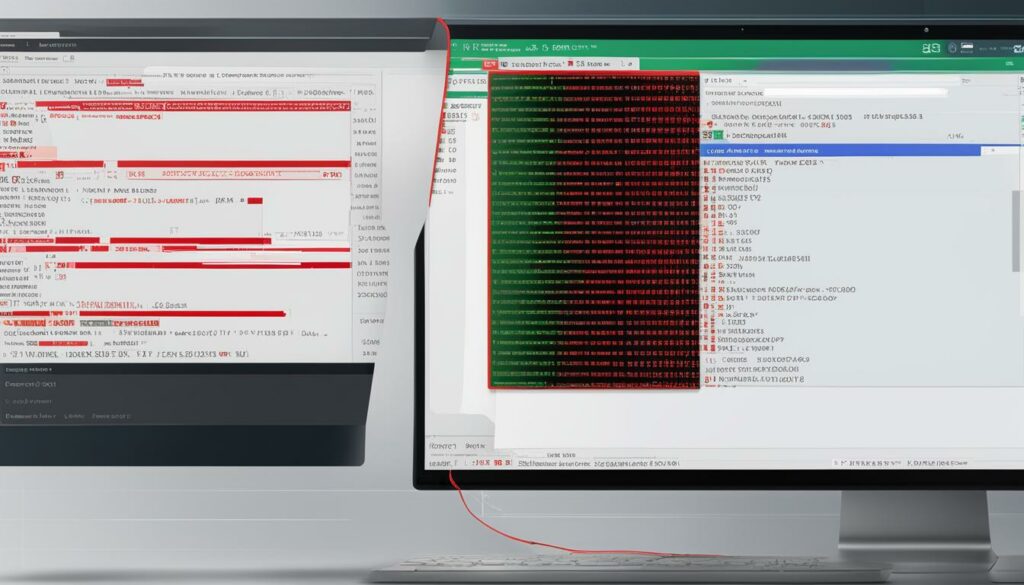Error handling in PHP is a critical aspect of web application development. It ensures that errors occurring during the execution of PHP scripts are captured, managed, and reported effectively. Implementing robust error handling strategies is essential for improving user experience, streamlining debugging, fortifying security, and preventing downtime.
In this article, we will explore the intricacies of PHP error handling and the significance of implementing error handling best practices in PHP applications. We will cover various topics, including error types, steps for error handling, exception handling, error control operators and constants, error handler functions, and advanced techniques for handling exceptions. Additionally, we will discuss the updates in error handling and exceptions introduced in PHP 7.
If you’re looking to build robust and reliable web applications, it’s crucial to master advanced PHP error handling techniques. By effectively managing errors and exceptions, you can enhance the quality and reliability of your applications. Let’s dive into the world of PHP error handling and take your web development skills to the next level!
Key Takeaways:
- Implementing PHP error handling best practices is crucial for building robust web applications.
- Effective error handling improves user experience, simplifies debugging, fortifies security, and prevents downtime.
- Understanding different error types and implementing proper error handling steps is essential.
- Exception handling allows for graceful error management and recovery in PHP applications.
- PHP 7 introduced significant changes in error handling and exceptions, enhancing their management and control.
The Significance of PHP Error Handling
PHP error handling is an essential aspect of web application development. It not only improves the user experience but also streamlines the debugging process, fortifies security, and prevents downtime. Let’s explore the significance of PHP error handling in more detail.
User Experience Improvement: Effective error handling ensures that users are presented with understandable and user-friendly error messages. This helps them to easily identify and understand the issues they encounter while using the web application, leading to a positive user experience.
Streamlined Debugging: Robust error handling mechanisms provide developers with valuable insights into the issues that arise during development. By capturing and reporting errors, debugging becomes a more streamlined process, enabling developers to spot and resolve issues more efficiently.
Security Fortification: Proper error handling helps fortify the security of web applications. It prevents the exposure of sensitive information to users, reducing the risk of security breaches. Secure error handling ensures that sensitive data remains protected and maintains the integrity of the application.
Preventing Downtime: By implementing effective error handling, web applications can continue running smoothly even when errors occur. This prevents system-wide failures and downtime, ensuring that users can access the application without interruption.
Maintainability and Future-Proofing: Well-organized error handling practices simplify maintenance and future development. With proper error handling mechanisms in place, it becomes easier to identify and resolve issues, making the application more maintainable. Additionally, error handling strategies can be designed to adapt to future changes and updates, ensuring the application remains future-proof.
BoostedHost WordPress Hosting Recommendation
“We recommend WordPress Hosting from BoostedHost for optimal performance. Sign up now through this link: www.boostedhost.com/wordpress-hosting.”
To further enhance your web development experience, BoostedHost offers reliable and efficient WordPress Hosting solutions. By choosing BoostedHost, you can ensure that your PHP error handling strategies are supported by a powerful hosting platform, optimizing the performance and reliability of your web applications.
Implementing robust PHP error handling practices is crucial for delivering exceptional user experiences, streamlining debugging processes, fortifying security measures, preventing downtime, and ensuring efficient application maintenance and future-proofing. By prioritizing error handling, you can create robust and reliable web applications that stand the test of time.
Types of PHP Errors
When developing PHP applications, it’s important to understand the different types of errors that can occur. These errors can be categorized based on their severity and provide valuable insights for debugging and troubleshooting. Let’s take a closer look at the various PHP error types:
1. Parse Errors
Parse errors occur when there are syntax mistakes in the PHP code. These errors prevent the interpreter from correctly parsing and interpreting the script. Common causes of parse errors include missing semicolons, mismatched parentheses, and undefined variables. To resolve parse errors, it’s essential to carefully review the code and fix any syntax errors.
2. Fatal Errors
Fatal errors are severe issues that halt the execution of the PHP script. These errors often indicate critical problems that prevent the script from running properly. They can be caused by missing or incompatible libraries, exhausted memory limits, or incorrect file permissions. Resolving fatal errors requires thorough debugging and addressing the underlying issues.
3. Warning Errors
Warning errors are less severe than fatal errors and don’t halt the script execution. Instead, they generate warning messages to alert developers about potential issues or questionable coding practices. These errors can be caused by undefined variables, deprecated functions, or incorrect function parameters. Though they don’t stop the script, it’s important to address warning errors to ensure the application’s stability and performance.
4. Notice Errors
Notice errors are the least severe type of PHP error. They indicate non-critical issues in the code that don’t pose a significant threat to the script’s execution. Notice errors are often caused by uninitialized variables, accessing array elements that don’t exist, or incorrect data types. Although they are less impactful, it’s still important to resolve notice errors to maintain code cleanliness and avoid potential bugs.
5. Deprecated Errors
Deprecated errors occur when using features or functions that have been marked as deprecated in PHP. Deprecated elements are still functional but will be removed or replaced in future versions of PHP. These errors serve as warnings to developers that they should update their code to use alternative approaches or functions. Resolving deprecated errors helps future-proof the application and ensures compatibility with upcoming PHP versions.
6. User-Defined Errors
PHP allows developers to define custom error codes and messages using the trigger_error() function. These user-defined errors provide flexibility in error handling and can be used to handle specific application scenarios or conditions. By defining and handling custom error codes, developers can implement specialized error management strategies tailored to their application’s requirements.
7. Exception Errors
Exceptions are a powerful error-handling mechanism in PHP that enables developers to handle and recover from exceptional situations. PHP offers a built-in try-catch block to catch and handle exceptions. Exception errors provide more detailed information about the encountered problem and allow for granular exception handling. They offer customization and flexibility in error management, enabling developers to create robust and resilient applications.
| Error Type | Description |
|---|---|
| Parse Errors | Errors in code syntax that prevent correct interpretation |
| Fatal Errors | Severe issues that halt script execution |
| Warning Errors | Less severe errors that generate warning messages |
| Notice Errors | Indicate non-critical issues in the code |
| Deprecated Errors | Errors related to the use of deprecated features or functions |
| User-Defined Errors | Custom error codes defined by developers |
| Exception Errors | Errors thrown and caught using exception handling |
Understanding the different types of PHP errors allows developers to effectively diagnose and resolve issues in their applications. By addressing these errors proactively, you can ensure the stability, security, and reliability of your PHP projects.
Steps for Error Handling in PHP
Effective error handling is a critical aspect of PHP development. By following these steps, you can ensure that errors in your PHP code are properly managed, debugged, and presented to users in a meaningful way.
- Identify and Classify Errors:
- Errors need to be identified and categorized based on their types, such as syntax errors, fatal errors, warning errors, notice errors, deprecated errors, user-defined errors, and exception errors.
- Handling specific errors involves using conditional statements, error suppression operators, or built-in functions that are tailored for error handling. This allows you to apply appropriate actions based on the nature and severity of each error.
- You can define a custom error handler function in PHP to handle errors in a way that suits your specific application needs. This allows for a more personalized and targeted approach in dealing with errors.
- Displaying user-friendly error messages is crucial in enhancing the overall user experience. By presenting clear and concise error messages, you enable users to understand the issue and take appropriate actions.
By following these steps, you can effectively handle errors in your PHP code, leading to improved application performance, enhanced user experience, and streamlined debugging processes. Remember to always strive for custom error handling and displaying user-friendly error messages, as they are vital components of error management in PHP.
BoostedHost Recommendation: WordPress Hosting
We recommend WordPress Hosting from BoostedHost for optimal performance in hosting your PHP applications. With their reliable infrastructure and top-notch support, BoostedHost ensures that your websites and web applications run smoothly, providing a seamless experience for your users. Sign up now through this link: www.boostedhost.com/wordpress-hosting.

| Error Type | Description |
|---|---|
| Parse Errors | Errors due to syntax mistakes that prevent correct interpretation of the PHP script. |
| Fatal Errors | Severe errors that halt script execution and often result from critical issues. |
| Warning Errors | Less severe errors that generate warning messages but don’t halt script execution. |
| Notice Errors | The least severe errors that indicate non-critical issues in the code. |
| Deprecated Errors | Errors that occur when using features or functions marked as deprecated. |
| User-Defined Errors | Errors that can be defined by the user to provide flexibility and customization. |
| Exception Errors | Errors that are thrown as exceptions and offer more control in error handling. |
Exception Handling in PHP
Exception handling is a fundamental aspect of PHP programming. It allows for graceful management of errors and unexpected situations, ensuring robust and reliable applications. Understanding the basics of exception handling is essential for every PHP developer.
The heart of PHP’s exception handling mechanism lies in its exception class hierarchy. At the top of the hierarchy is the generic Exception class. However, custom exception classes can be created to provide more specific context to exceptions, allowing for more precise error management.
An important aspect of exception handling is the use of descriptive exception messages. These messages provide valuable information for debugging and troubleshooting, making it easier to identify and resolve issues in the code.
When exceptions occur, logging them becomes crucial for diagnosing and analyzing problems in a production environment. By logging exceptions, developers can gain insights into the occurrence and frequency of specific error scenarios, helping to improve the reliability and stability of the application.
The finally block in exception handling allows for the execution of code regardless of whether an exception was thrown or not. This ensures that necessary clean-up operations or code actions take place even in the presence of exceptions, promoting better resource management and system stability.
A common mistake in exception handling is the use of error suppression, denoted by the “@” symbol. Error suppression should be avoided as it masks errors and prevents them from being properly handled. It is important to catch and handle exceptions explicitly, allowing for complete control and transparency in error management.
Another crucial aspect of exception handling is ensuring that exceptions are handled at the appropriate level in the application. By handling exceptions at the appropriate level, code becomes more maintainable and error management becomes more effective. It is important to avoid catching exceptions too early or too late in the application flow.

| Benefits of Exception Handling in PHP |
|---|
| Enhances code reliability |
| Simplifies error detection and resolution |
| Improves debugging and troubleshooting |
| Promotes better code organization and maintainability |
| Enhances user experience through meaningful error messages |
Error Control Operator and Error Constants
When it comes to error handling in PHP, it’s essential to understand the error control operator and error constants. Let’s dive into these concepts and see how they contribute to robust error management and debugging in PHP.
The Error Control Operator
In PHP, the error control operator “@” allows for error suppression. When you use “@” before a statement, PHP will not display any errors or warnings that may occur. However, it is generally not recommended to use the error control operator excessively, as it can make debugging more challenging. It’s better to address errors explicitly, so you can identify and fix issues effectively.
Error Constants in PHP
PHP provides error constants that represent different types of errors. These constants help configure PHP to display or hide errors of certain classes. Here are some commonly used error constants:
| Error Constant | Error Type |
|---|---|
| E_DEPRECATED | Deprecated features or functions |
| E_STRICT | Suggestions for code improvements and future compatibility |
| E_PARSE | Parse errors in code syntax |
| E_NOTICE | Non-critical issues in code |
| E_ERROR | Fatal errors that halt script execution |
| E_RECOVERABLE_ERROR | Recoverable fatal errors |
By using these error constants appropriately, you can control the behavior of error reporting in your PHP application, making it easier to handle and address different types of errors.

Error Handler Function and Displaying Errors
When it comes to managing errors in PHP, the set_error_handler() function plays a crucial role. This function allows you to define how PHP handles standard engine errors that are not instances of the Error exception class. By utilizing this function effectively, you can customize the error handling process to suit the specific needs of your web application.
One of the main aspects of error handling is the proper display of errors. In PHP, you have the option to either display or suppress error messages. The behavior can be controlled through the configuration of the display_errors setting in the php.ini file. Enabling display_errors allows errors to be shown directly on the web page, helping you identify and address them quickly.
On the other hand, if you prefer to log errors rather than display them to end users, you can configure the log_errors setting. This setting directs the PHP engine to log errors to a specified file on the server, making it easier for developers to review and troubleshoot issues without exposing them to end users.
To ensure that the appropriate errors trigger a report, you can use the error_reporting setting. This setting allows you to specify the level of error reporting you want PHP to perform. By defining the appropriate level, you can control which errors are logged or displayed, helping you focus on the most critical issues.
Proper error handling involves not only displaying errors but also logging them. Logging errors provides a valuable record of each error occurrence, enabling you to track and analyze patterns for troubleshooting and improvement purposes. Utilizing error logging helps you gain insights into recurring issues and implement targeted solutions.
To enhance error handling practices, it’s essential to follow best practices. This includes making use of informative and user-friendly error messages that provide helpful context to users when errors occur. Well-crafted error messages can significantly improve the user experience by helping users understand what went wrong and guiding them toward a possible solution.
Remember, suppressing error messages is not recommended as it can hinder the debugging process. It’s crucial to let errors surface during development and testing stages so that you can identify and address them promptly. Avoiding the suppression of error messages allows for thorough error management and a cleaner development process.
Error Handling Best Practices
When it comes to handling errors in PHP, here are some best practices to keep in mind:
- Properly configure the display_errors and log_errors settings to control error visibility and capture them for later analysis.
- Define and document your error handling strategies to ensure consistency across your web application.
- Craft informative and user-friendly error messages that provide helpful context to end users.
- Log errors to maintain a record of occurrences and facilitate troubleshooting.
- Avoid suppressing error messages during development and testing stages to ensure effective debugging.

| Error Handling Best Practices |
|---|
| Proper configuration of display_errors and log_errors settings |
| Clear documentation of error handling strategies |
| Creation of informative and user-friendly error messages |
| Logging errors for analysis and troubleshooting |
| Avoiding suppression of error messages during development and testing |
Exception Handling Best Practices
Exception handling is a critical aspect of building robust and reliable web applications. To ensure that your application gracefully handles errors and provides a smooth user experience, it’s essential to follow these exception handling best practices:
- Catching Exceptions: When catching exceptions, make sure to handle them in a way that allows for proper error management. By catching exceptions at the appropriate level, you can take specific actions to address the errors and prevent application crashes.
- Custom Exception Classes: Creating custom exception classes can provide more context and tailored handling for different types of exceptions. By extending the base
Exceptionclass, you can include additional information that helps in debugging and resolving issues. - Exception Bubbling: Exception bubbling refers to the propagation of exceptions through the call stack. When an exception is thrown and not caught, it bubbles up through the function calls until it is handled or reaches the top-level error handler. Bubbling allows for centralized exception handling and improves error detection and reporting.
- Error Hierarchies: Implementing error hierarchies can help categorize and prioritize exceptions. By defining an error hierarchy, you can better organize and manage exceptions based on their severity and impact on application functionality.
- Handling Multiple Exceptions: Handling multiple exceptions in a single catch block can improve code readability and reduce duplication of handling logic. By grouping similar exceptions, you can perform common actions for a specific set of exceptions, streamlining your error handling process.
- Graceful Degradation: Graceful degradation refers to the ability of an application to recover from certain errors and continue functioning. By implementing fallback mechanisms and alternative approaches, you can ensure that your application provides a smooth user experience even in the presence of errors.
- Testing Exception Handling: Thoroughly testing your exception handling code is crucial to ensure that it performs as expected in various scenarios. By simulating different error conditions and verifying the behavior of your exception handling code, you can identify and fix any potential issues before they impact your application.
By following these exception handling best practices, you can build more robust and reliable PHP applications that effectively handle errors and provide a seamless user experience.
Advanced Techniques for Exception Handling
In addition to the basic concepts of exception handling, there are advanced techniques that can further enhance the robustness and reliability of exception handling in PHP applications.
Exception Chaining: One such technique is exception chaining. With exception chaining, a previously caught exception is passed as an argument when constructing a new exception. This allows for retaining the context of the original exception, which can be valuable for debugging purposes.
Example:
try { // Code that may throw an exception } catch (PreviousException $e) { throw new NewException("An error occurred", 0, $e); }
Handling Multiple Exceptions: Handling multiple exceptions in a single catch block can improve code readability and reduce duplication of handling logic. This technique allows you to catch and handle different exception types in a more concise and organized manner.
Example:
try { // Code that may throw exceptions } catch (ExceptionType1 | ExceptionType2 | ExceptionType3 $e) { // Handle exceptions }
Advanced Exception Handling Strategies: Depending on the architecture of your application, you may consider implementing advanced exception handling strategies. This can include centralizing exception handling in a separate component or integrating with third-party error tracking systems for better monitoring and notifications.
Implementing these advanced techniques can significantly enhance your error management capabilities and contribute to the overall reliability of your PHP applications.
Next, let’s explore the changes in error handling and exceptions introduced in PHP 7.
Error Handling and Exceptions in PHP 7
PHP 7 introduced significant changes in error handling and exceptions, providing developers with improved tools and techniques to manage errors effectively. These updates enhance the overall stability and reliability of PHP applications.
The Throwable interface serves as the foundation for objects that can be thrown using the throw statement. It allows for a unified approach to error handling in PHP 7. The Error and Exception classes in PHP 7 implement the Throwable interface, providing a standardized way to handle both errors and exceptions.
PHP 7 also introduces a set of Error constants that offer finer control over error reporting and suppression. By utilizing these constants, developers can tailor the PHP environment to display or hide specific types of errors based on their desired configuration.
Furthermore, PHP 7 provides the ability to define a custom error handler function using the set_error_handler() function. This allows developers to define their own error handling logic, enabling more precise control over error behavior and messages.
In terms of error message display, PHP 7 provides flexibility by allowing developers to configure error messages to be shown or suppressed depending on the desired environment, be it development or production. This ensures that error messages are displayed only when necessary, reducing unnecessary noise in production environments.
To summarize, the advancements in error handling and exceptions in PHP 7, including the Throwable interface, Error and Exception classes, Error constants, error handler function, and configurable error message display, provide developers with powerful tools to effectively manage and handle errors in their PHP applications.
| Error Handling and Exceptions in PHP 7 |
|---|
| Throwable interface |
| Error and Exception classes |
| Error constants |
| Error handler function |
| Displaying and suppressing error messages |
Conclusion
Implementing advanced PHP error handling techniques and best practices is crucial for building robust and reliable web applications. Effective error handling improves user experience, streamlines debugging, fortifies security, and prevents downtime. By following the steps for error handling, mastering exception handling, and adopting advanced techniques, you can create code that gracefully manages errors and enhances the quality of your applications.
Robust error handling is a paramount concern for any PHP developer, contributing to the overall reliability and success of web applications. With vigilant error handling, you can ensure a smooth user experience by presenting user-friendly error messages. Streamlining the debugging process allows for quicker problem identification and resolution. Proper error handling also fortifies the security of your applications by preventing the exposure of sensitive information. Lastly, proactive error management prevents system-wide failures and minimizes potential downtime.
In summary, by implementing advanced PHP error handling techniques and adhering to best practices, you can create robust web applications that deliver an exceptional user experience, maintain top-notch security, and minimize disruptions. For optimal performance and reliable hosting, we recommend WordPress Hosting from BoostedHost. Sign up now through this link to ensure your PHP applications run smoothly.
FAQ
Q: What is PHP error handling?
A: PHP error handling involves capturing, managing, and reporting errors that occur during the execution of PHP scripts.
Q: Why is error handling important in PHP?
A: Error handling in PHP is important because it improves the user experience, streamlines debugging, fortifies security, and prevents downtime.
Q: What are the types of PHP errors?
A: PHP errors can be categorized into several types, including parse errors, fatal errors, warning errors, notice errors, deprecated errors, user-defined errors, and exception errors.
Q: What are the steps for error handling in PHP?
A: The steps for error handling in PHP include identifying and classifying errors, handling specific errors, implementing custom error handling, and displaying user-friendly error messages.
Q: What is exception handling in PHP?
A: Exception handling in PHP allows for graceful management of errors and unexpected situations, providing a unified approach to error handling.
Q: How can I handle exceptions in PHP?
A: Exceptions in PHP can be handled by catching them in a try-catch block, creating custom exception classes for more context, logging exceptions for diagnostics, and utilizing the finally block for code execution regardless of exceptions thrown.
Q: What is the error control operator in PHP?
A: The “@” symbol is used as the error control operator in PHP to suppress error messages. However, it is generally not recommended to use this operator.
Q: What are error constants in PHP?
A: Error constants in PHP, such as E_DEPRECATED, E_STRICT, E_PARSE, E_NOTICE, E_ERROR, and E_RECOVERABLE_ERROR, provide more control over error reporting and suppression.
Q: How can I define an error handler function in PHP?
A: The set_error_handler() function in PHP is used to define custom error handler functions for handling standard engine errors that are not instances of the Error exception class.
Q: How can I display errors in PHP?
A: Errors can be displayed in PHP by configuring the display_errors and log_errors settings in the php.ini file, along with the error_reporting setting determining which errors trigger a report.
Q: What are best practices for exception handling in PHP?
A: Best practices for exception handling in PHP include catching exceptions effectively, creating custom exception classes, utilizing exception bubbling and error hierarchies, handling multiple exceptions, and testing exception handling thoroughly.
Q: What are some advanced techniques for exception handling in PHP?
A: Advanced techniques for exception handling in PHP include exception chaining for retaining context, handling multiple exceptions in a single catch block for improved code readability, and adopting advanced exception handling strategies based on the application’s architecture.
Q: What are the updates in PHP 7 for error handling and exceptions?
A: PHP 7 introduced updates such as the Throwable interface, Error and Exception classes implementing the Throwable interface, fine-grained control over error reporting and suppression with Error constants, and enhanced error handling functions.
Q: Why is advanced PHP error handling important for web applications?
A: Implementing advanced PHP error handling techniques and best practices is crucial for building robust and reliable web applications, ensuring improved user experience, streamlined debugging, enhanced security, and prevention of downtime.












